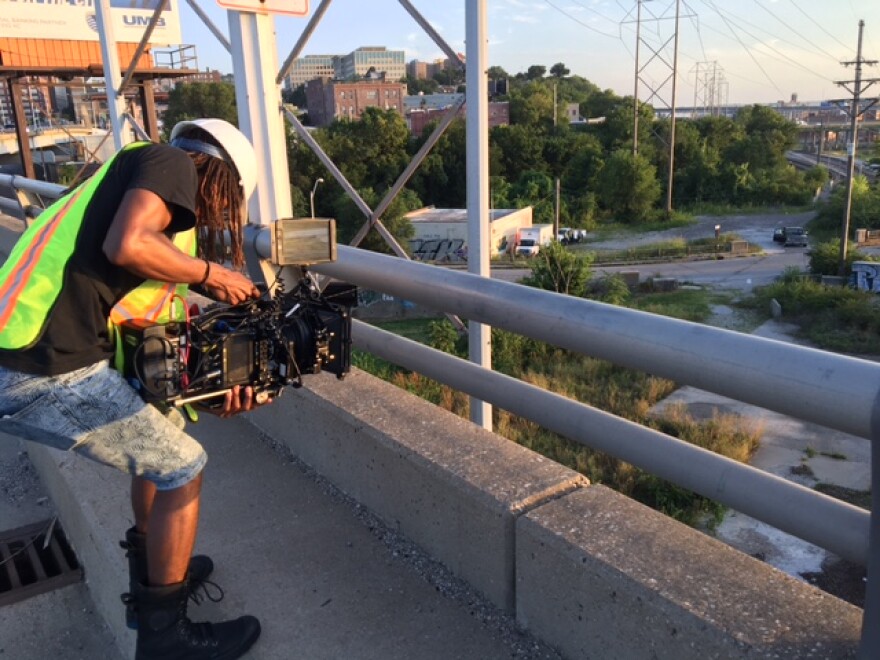Two cars cruise into Kansas City. In one, a man and woman battling poverty and bad luck try to outrun their past. The other is a battered old Jeep Wrangler, in which two estranged sisters attempt to reconnect after a wedding catastrophe.
The stories seem as different as can be but share a key factor: They are the first two feature films to be shot in Kansas City after the establishment of the Film and Media rebate incentive.
The films also share local connections. All Creatures Here Below is the gritty drama written by, and starring, Overland Park native David Dastmalchian, while Kansas City’s Morgan Dameron writes, directs and produces Different Flowers, which she describes as a “love story about sisters.”
Dameron and All Creatures producer Amy Greene Vines agree that Kansas City was unexpectedly welcoming and easy to shoot in. The landscape allows different parts of the city to pass for Oklahoma, Arizona and even California.
“We originally planned on only shooting the Kansas City scenes here,” Greene Vines says. “But once we saw the diversity of the landscapes around – and how inexpensive it is to work here, compared to someplace like Los Angeles – we ended up gradually deciding to shoot 95 percent of the film in and around Kansas City.”
“We came out to scout locations and we were just checking off one scene after another,” adds All Creatures director Collin Schiffli. The production team returned to Los Angeles primarily to get establishing shots of that city’s skyline.
The filmmakers say they were also surprised at the wealth of local talent and resources.

Dameron says she was excited to find photogenic locations such as Leed’s Diner in the West Bottoms and a private farmhouse outside of the city she used to stand in for a setting inspired by her grandparents’ farm. Schiffli also mentioned shooting at Leed’s, which apparently has universal cinematic appeal.
Dameron says she expected difficulty finding the right Wrangler, an admittedly specific demand, but that turned out to be fairly easy.
“It had just shown up at this used car dealership – the Wrangler is an important element of the story; it ends up being almost a character itself,” she says.
Greene Vines and Schiffli emphasize that the quality of talent is equal to any other city’s.
“We used a local wardrobe shop, casting director, most of our supporting cast and a lot of our grip and electric crews,” Greene Vines says. “They are all unbelievable. I’d happily take this cast and crew with me to work on a production anywhere.”
Because Kansas City is relatively new to hosting productions of this size, there were some gaps in the city’s resources.
“A local camera house would be helpful,” Greene Vines notes. “We had to bring in all of that equipment, and if we broke a lens we’d have to wait for a new one to ship in.”
Talent trailers – the mobile makeup facilities and dressing rooms the cast and crew hang out with between scenes – were also non-existent.

“We drove these in from places like New Orleans,” Greene Vines says.
And Kansas City hasn’t yet established the sorts of vendors that cater to production crews. Picture car vendors, for example, rent out the vehicles used in movies – anything from police cars or city buses to an ice cream truck. Without access to a picture car vendor, Schiffli had to improvise.
“Coincidentally, the newer Kansas City buses are modeled off of Los Angeles,’” he says with a laugh. “We were able to find one that didn’t have the city decals on it yet, so that was lucky.”
More urgent than cars, the casts and crews on sets need to eat.
Dameron, who until recently was a production assistant to JJ Abrams on films like Star Wars: The Force Awakens, notes that in cities like Los Angeles and Chicago, caterers are accustomed to craft services.
“Restaurants and caterers here are used to dealing with a wedding or a party, but when you start talking about multiple meals for a large group for a week – people were great about working with us,” she says, “it was just a new request for them.”
But both groups of filmmakers cited obvious benefits to shooting in a smaller city – “a small budget goes a lot further here,” Greene Vines notes – and Kansas City hasn’t established the types of fees required for shooting permits common in other frequently filmed locations.
And for the most part, neither crew found the small size of the city to be a liability.
“Even without the local connection like we have with this film,” Greene Vines says, “I’d shoot here again in a heartbeat.”
Neither film is yet in post-production, and the filmmakers tentatively estimated their movies might be out sometime in 2017.
Meanwhile, living here during production, Schiffli says, “has almost felt like a vacation.”
Melissa Lenos is an Assistant Professor of English at Donnelly College, where she teaches film studies, composition, literature and popular culture. She can be reached at melissalenos@gmail.com.




